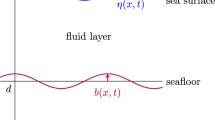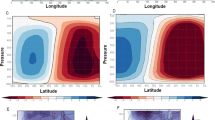Abstract
We describe the solutions of a numerical two-layer primitive equation model of an idealized Strait of Gibraltar and an adjacent eastward basin. The quasi-steady circulation pattern in the basin features an anticyclonic gyre southward of the strait exit and an eastward boundary current attached to the southern boundary of the basin. A variation of the initial upper-layer depth and the target interface height at the eastern boundary causes minor changes of the upper-layer circulation in a basin with rectangular coastline and larger changes when a cape is added to the coastline of the southern boundary.












Similar content being viewed by others
References
Bormans M, Garrett C (1989a) The effect of rotation on the surface inflow through the Strait of Gibraltar. J Phys Oceanogr 19(10):1535–1542
Bormans M, Garrett C (1989b) The effects of non-rectangular cross-section, friction and barotropic fluctuations on the exchange through the Strait of Gibraltar. J Phys Oceanogr 19:1543–1557
Bormans M, Garrett C, Thompson K (1986) Seasonal variability of the surface inflow through the Strait of Gibraltar. Oceanol Acta 9:403–414
Bryden H, Kinder T (1991) Steady two-layer exchange through the Strait of Gibraltar. Deep-Sea Res A Oceanogr Res Pap 38(1):S445–S463
Bryden HL, Stommel HM (1982) Origin of the Mediterranean outflow. J Mar Res 40:55–71
Bryden H, Stommel H (1984) Limiting processes that determine basic features of the circulation in the Mediterranean Sea. Oceanol Acta 7(3):289–296
Candela J, Winant C, Bryden H (1989) Meteorologically forced subinertial flows through the Strait of Gibraltar. J Geophys Res 94(C9):12667–12
Candela J, Winant C, Ruiz A (1990) Tides in the Strait of Gibraltar. J Geophys Res 95(C5):7313–7335
Dalziel S (1991) Two-layer hydraulics: a functional approach. J Fluid Mech 223(1):135–163
Farmer D, Armi L (1986) Maximal two-layer exchange over a sill and through the combination of a sill and contraction with barotropic flow. J Fluid Mech 164(1):53–76
Farmer D, Armi L (1988) The flow of Atlantic water through the Strait of Gibraltar. Prog Oceanogr 21(1):1–103
García Lafuente J, Delgado J, Vargas J, Vargas M, Plaza F, Sarhan T (2002a) Low frequency variability of the exchanged flows through the Strait of Gibraltar during CANIGO. Deep Sea Res 49:4051–4067
García Lafuente J, Fanjul E, Vargas J , Ratsimandresy A (2002b) Subinertial variability in the flow through the Strait of Gibraltar. J Geophys Res 107:3168
Hallberg R (1995) Some aspects of the circulation in ocean basins with isopycnals intersecting sloping boundaries. PhD Thesis, University of Washington, pp. 244
Hallberg RW, Rhines PB (1996) Buoyancy-driven circulation in an ocean basin with isopycnals intersecting the sloping boundary. J Phys Oceanogr 26:913–940
Heburn G, La Violette P (1990) Variations in the structure of the anticyclonic gyres found in the Alboran Sea. J Geophys Res 95:1599–1613
Henderson F (1966) Open channel flow. Macmillan, New York
Kinder T, Parrilla G (1987) Yes, some of the Mediterranean outflow does come from great depth. J Geophys Res 92(C3):2901–2906
Klinger B (1994) Inviscid current separation from rounded capes. J Phys Oceanogr 24(8):1805–1811
Lanoix F (1974) Project Alboran; etude hydrologique et dynamique de la mer d’Alboran: d’apres les travaux effectues dans le cadre du project Alboran (Juillet et aout 1962). Technical Report 66, NATO, Brussels, p. 39
Mariotti A, Struglia M, Zeng N, Lau K (2002) The hydrological cycle in the mediterranean region and implications for the water budget of the Mediterranean Sea. J Clim 15(13):1674–1690
Millot C (1999) Circulation in the Western Mediterranean Sea. J Mar Syst 20(1):423–442
Millot C (2009) Another description of the Mediterranean Sea outflow. Prog Oceanogr 82(2):101–124
Naranjo C, García Lafuente J, Sánchez Garrido JC, Sánchez Román A, Delgado Cabello J (2012) The western Alboran gyre helps ventilate the western Mediterranean deep water through Gibraltar.Deep Sea Res Part I: Oceanogr Res Pap 63:157–163
Parrilla G, Kinder T (1987) Oceanografía física del mar de Alborán.Bol Inst Esp Oceanogr 4(1):133–165
Parrilla G, Kinder TH, Preller RH (1986) Deep and intermediate Mediterranean water in the western Alboran Sea. Deep Sea Res Part A Oceanogr Res Pap 33(1):55–88
Perkins H, Kinder T, La Violette P (1990) The Atlantic inflow in the western Alboran Sea. J Phys Oceanogr 20(2):242–263
Preller RH (1986) A numerical model study of the Alboran Sea gyre. Prog Oceanogr 16(3):113–146
Renault TL, Oguz A, Pascual G, Vizoso Tintore J (2012) Surface circulation in the Alboran Sea (Western Mediterranean) inferred from remotely sensed data. J Geophys Res:117
Romanou A, Tselioudis G, Zerefos C, Clayson C, Curry J, Andersson A (2010) Evaporation-precipitation variability over the Mediterranean and the Black Seas from satellite and reanalysis estimates. J Clim 23(19):5268–5287
Speich S, Madec G, Crepon M (1996) A strait outflow circulation process study: the case of the Alboran Sea. J Phys Oceanogr 26(3):320–340
Stern M, Whitehead J, Hua B (1982) The intrusion of a density current along the coast of a rotating fluid. J Fluid Mech 123:237–265
Stommel H, Bryden H, Mangelsdorf P (1973) Does some of the Mediterranean outflow come from great depth Pure Appl Geophys 105(1):879–889
Timmermans M, Pratt L (2005) Two-layer rotating exchange flow between two deep basins: theory and application to the Strait of Gibraltar. J Phys Oceanogr 35(9):1568–1592
Tintoré J, Viúdez A, Gomis D, Alonso S, Werner F (1994) Mesoscale variability and q vector vertical motion in the Alboran Sea. In: La Violette P (ed) Seasonal and interannual variability of the Western Mediterranean Sea, Coastal and Estuarine Studies, vol 46, American Geophysical Union, chap 4, pp. 47–71
Viúdez A, Tintoré J, Haney RL (1996) Circulation in the Alboran Sea as determined by quasi-synoptic hydrographic observations. Part I: Three-dimensional structure of the two anticyclonic gyres. J Phys Oceanogr 26:684–705. doi:10.1175/1520-0485(1996)026<0684:CITASA>2.0.CO;2
Werner F, Cantos-Figuerola A, Parrilla G (1988) A sensitivity study of reduced-gravity channel flows with application to the Alborán Sea. J Phys Oceanogr 18(2):373–383
Whitehead J, Leetmaa A, Knox R (1974) Rotating hydraulics of strait and sill flows. Geophys Astrophys Fluid Dyn 6(2):101–125
Acknowledgments
The authors are indebted to two anonymous reviewers, who helped to greatly improve a first draft of this article. This work was partially funded by the Portuguese Science Foundation (FCT) under project MedEx (MARIN-ERA/MAR/0002/2008).
Author information
Authors and Affiliations
Corresponding author
Additional information
Responsible Editor: Richard Signell
Appendix
Appendix
In our modeling approach, the buoyancy gain of the eastern basin by the flow through the strait is canceled by the buoyancy loss within the restoring column at the eastern boundary (in quasi-steady state after the spin-up phase). To preserve some analogy between the model and reality, the intensity of this buoyancy loss should be representative for the time-averaged, area-integrated evaporative buoyancy loss over the Mediterranean. Following (Bryden and Stommel 1984), we use a linearized equation of state and neglect the thermal contributions to density changes. The salt export from the eastern basin by the purely baroclinic flow through our model strait must then be in a range that can be canceled by a hypothetical barotropic inflow (and associated salinity import) through the strait which is in agreement with reasonable estimates for freshwater deficit.
For simplicity, we assume here that the addition of a barotropic component E to the velocity profile within the strait does not change the baroclinic structure of the flow. In the following, we assume \(Q_2=-Q_1\), where Q represents the time-averaged volume flux. Using a linearized equation of state with the parameters \(\rho (S)=\rho _0+\rho '=\rho _0(1+\beta (S-S_0))\) with \(S_0=36.5\), \(\beta =7.5\cdot 10^{-4}\), and \(\rho _0=1027.6\) kg/m\(^3\), we search for a barotropic volume flux E satisfying
Setting \(S_1=S_0\), we find for \(\Delta \rho =2\) kg/m\(^3\) (or equivalently \(S_2=39.10\) PSU) and \(Q_1\) from BASIC−20 (Table 1): E=0.061 Sv. For \(\Delta \rho =1.5\) kg/m\(^3\) (\(S_2=38.45\) PSU) and \(Q_1\) from LIGHT−20 (Table 2): E=0.039 Sv. For \(\Delta \rho =2.5\) kg/m\(^3\) (\(S_2=39.74\) PSU) and \(Q_1\) from DENSE−20 (Table 2): 0.087 Sv. The difference between these values for E are in the same range of magnitude as the differences between estimates for mean freshwater deficit over the Mediterranean from observations. For example, (Romanou et al. 2010) report a mean freshwater deficit over the Mediterranean and Black Sea of 0.07 Sv. based on satellite data. (Mariotti et al. 2002) estimate the mean Mediterranean Sea water loss from reanalysis and observational data to be in the range from 0.04 to 0.056 Sv. In this context, it is instructive to determine the influence of rotation on the transport through the strait. Repeating experiment BASIC−20 with \(f=\beta =0\) yields \(\overline {Q}_1\)=1.053 Sv (E=0.072 Sv), which is an increase of almost 18 % compared to \(\overline {Q}_1\) from BASIC−20. To compare this two-dimensional nonrotating solution with the maximal-exchange solution of a one-dimensional nonrotating model, we adjust the model used by (Bryden and Kinder 1991) by setting the parameters for strait width at the sill and the contraction to the values of our model topography (22 and 14 km, respectively), and obtain from their Eq. (22) \(\overline {Q}_1\)=1.025 Sv.
Rights and permissions
About this article
Cite this article
Riha, S., Peliz, A. A two-layer primitive equation model of an idealized Strait of Gibraltar connected to an eastern basin. Ocean Dynamics 63, 615–631 (2013). https://doi.org/10.1007/s10236-013-0621-5
Received:
Accepted:
Published:
Issue Date:
DOI: https://doi.org/10.1007/s10236-013-0621-5




